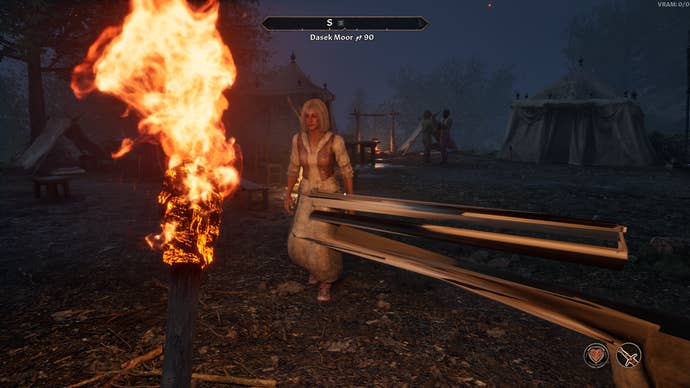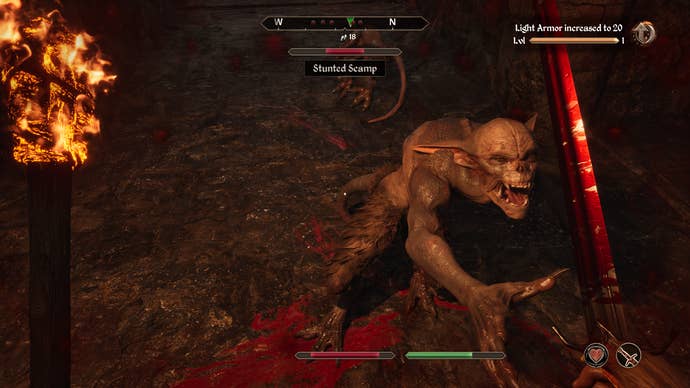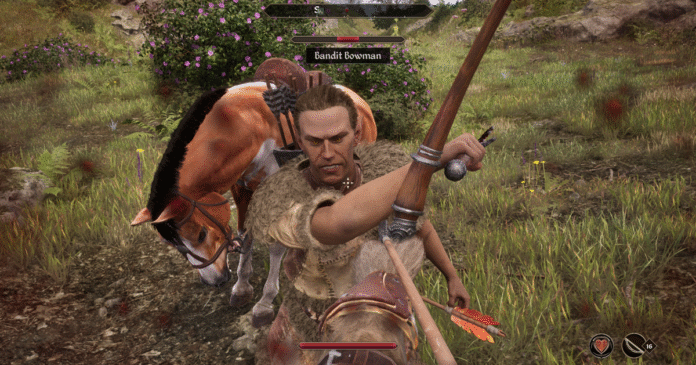The Elder Scrolls IV: Oblivion Remastered is one of those rare games I’ll grind out a performance and settings feature for before continuing to play it – yee gads, what a concept – for fun. It’s more or less exactly what I’d have asked from a modern take, with refreshed visuals and UX improvements bolted directly onto Oblivion’s original, famously bent chassis.
This hybrid engine approach, similar to that of Ninja Gaiden 2 Black, hands off the graphical rendering gubbins to an Unreal Engine 5 layer while keeping all the game logic to a modified version of what is otherwise just the 2006 backend. Preserving, in the process, that janky daftness that accounts for much of Oblivion’s charm, with qualified support for the original’s mods on the side. Still, the performance impact of Oblivion Remastered’s new look is not to be trifled with. Even with DLSS/FSR upscaling support and frame generation, this is a tough one to run smoothly at its highest settings, especially if you deploy the ray tracing effects that (for once) really do enhance and enliven the scenery.
Lower-end gear isn’t off the table – even the Steam Deck can manage reasonable framerates – though I will recommend some tactical quality reductions in the guide further down. First, and because its, uh, attempt at shadowdropping meant we skipped the usual pre-release infodumps, let’s get acquainted with Oblivion Remastered’s system requirements and how they measure up to performance reality.
The Elder Scrolls IV: Oblivion Remastered system requirements and PC performance
These aren’t the haughtiest requirements I’ve seen from a UE5 production, to be fair. Graphics cards like the RX 5700 and GTX 1070 Ti will probably seem like excessive minimums to anyone still playing OG Oblivs on their GeForce 7600 GT, but they’re old themselves by 2025 standards. I’m more concerned about the recommended list’s 32GB of RAM, which ain’t a little, and the bulging 125GB SSD requirement. That’s quite the pile of high-def chainmail textures.
The Elder Scrolls IV: Oblivion Remastered minimum PC specs
- OS: Windows 10 version 21H1 (10.0.19043)
- CPU: AMD Ryzen 5 2600X / Intel Core i7-6800K
- RAM: 16GB
- GPU: AMD Radeon RX 5700 / Nvidia GeForce GTX 1070 Ti
- DirectX: Version 12
- Storage: 125GB available space, SSD required
The Elder Scrolls IV: Oblivion Remastered recommended PC specs
- OS: Windows 10/11 (with updates)
- CPU: AMD Ryzen 5 3600X / Intel Core i5-10600K
- RAM: 32GB
- GPU: AMD Radeon RX 6800XT / Nvidia GeForce RTX 2080
- DirectX: Version 12
- Storage: 125GB available space, SSD required
There’s no getting around the remaster’s considerable girth, though evidence suggests that at least the GPU requirements err on the overly cautious. In the relatively demanding overworld section I used for benchmarking, the GTX 1070 – that’s the base, non-Ti version – averaged a more-than-adequate 43fps at 1080p, simply using the Low preset. The GTX 1070 Ti should, therefore, be plenty.
Elsewhere in the cheaper neighbourhoods of PC hardware, the RTX 4060 could just about handle the Ultra preset at 1080p, scoring 33fps. High would be a better starting point, though, producing 53fps, while Medium pumped out a nifty 80fps. Steering clear of Ultra also worked out for the RTX 3070, which on the High preset ended up with 59fps at 1080p, as well as 55fps at 1440p after adding DLSS on Quality mode. Just to get in some premium representation, I also tried the RTX 5080 at 4K, where (on the Ultra preset with DLSS on Quality) it averaged 62fps before climbing to 105fps with frame generation.
You’ll note that none of these results are especially horrid, and to be clear, these are averages taken from a more straining patch of Cyrodiil; castles, caves, and dungeons will run much faster, owing to their simpler and tighter interiors. Even so, that lack of consistency is a concern in itself, since you essentially need to tune Oblivion Remastered’s graphics settings for a kind of worst-case scenario. What’s more, all of those results use the default Lumen lighting effect setting of Low-quality, software-based ray tracing, which isn’t very demanding but lacks the depth and the detailing that hardware-based Lumen offers in exchange for its higher frame tax.
Sadly, the biggest performance headache seems to flare up regardless of how mighty your hardware is: our old friend, stutter. This is a regular occurrence when free-roaming, with hitch-fits sometimes lasting for several seconds, and can even occur when performing such mundane tasks as exiting the waiting screen or opening the pause menu. Some patching work is definitely needed here, and in truth, some of the new visuals could do with touchups while Virtuos are at it. I’ve repeatedly seen glimmers of equipped weapons or nearby trees erroneously melded into screen space reflections, and whatever this lady is doing with her skirt, ma’am, it isn’t working.

Weirdly, the remaster still feels like it improves the structural integrity of Oblivion as well as the graphical fidelity. Install the original game today without mods and you’ll find no shortage of unfixed technical bizarreries, from hideous blurring on high framerates to a deranged options menu that disables anti-aliasing on the Ultra preset because the game thinks AA and HDR lighting are mutually exclusive. Oblivion Remastered has bugs and stuttering, sure, but it’s not broken and/or mad in the same kinds of ways – you just need to make sure that when framerates fall, you’ve given yourself enough headroom to stay out of the red.

The Elder Scrolls IV: Oblivion Remastered best settings
Actually, correction: Oblivion Remastered can be a tiny bit mad. The relative performance of each quality preset is far, far more than the some of their parts – when I tested each setting individually, lowering them from Ultra to Medium to see which ate up the most frames, only shadows quality had a major impact. This would suggest that all the others could be left on Ultra with minimal performance drawback, except shadows alone couldn’t account for the vast differences between each preset. On the RTX 4060, remember, Ultra averaged 33fps at 1080p while Medium averaged 80fps, yet setting only shadow quality to Medium (and keeping everything else on Ultra) only produced 43fps.
I’m therefore going to suggest High, rather than Ultra, as a starting point from which to make further tweaks. There’s evidently some manner of Voltron effect with most of the individual settings, where cutting them piecemeal achieves little compared to gathering a whole set of reductions together, and it’s not like High is ugly anyhow.
Nevertheless, it’s worth dropping shadows another level down, and I did get a smaller framerate boost from snipping global illumination quality, so that makes the list as well. Here’s what I’ve landed on:
- Motion blur: Off
- Screen space reflections: On
- Shadow quality: Medium
- Global illumination quality: Medium
- Upscaling technique: DLSS/FSR 3 on Quality
- Lumen hardware RT: On
- Lumen hardware RT lighting mode: High
- Everything else: High
Hardware-based RT can be skipped if you’re on an older GPU that isn’t up to it, but otherwise, this is the one luxury you should afford yourself if you can. It might not replicate the original game’s blinding bloom but it does deliver more of a sun-kissed look that suits the leafy Cyrodiil rather well. Lowering shadows and global illumination, while adding upscaling, also provides the framerate headroom to accommodate ray traced effects: on the RTX 4060 at 1080p, these settings scored 63fps, nearly double the speed of the Ultra preset just with software-based RT. By comparison, the same settings with software Lumen on Low quality produced 74fps, so the smoothness gap isn’t some yawning chasm.
Also, I wouldn’t consider it important enough to include in a list of the air-quote “best” settings, but DLSS frame generation also works fairly well if you’re already pumping out at least 60fps or so without it; this healthy supply of traditionally rendered frames helps absorb the input lag increase from sprinkling in the generated frames. I wouldn’t bother with FSR frame gen, though. Even with a strong foundation of normal frames, it has less of a grasp on consistent frame timings, so the results are noticeably less smooth than DLSS when walking. And this is still a Bethesda RPG, so there’s a fair bit of that.

